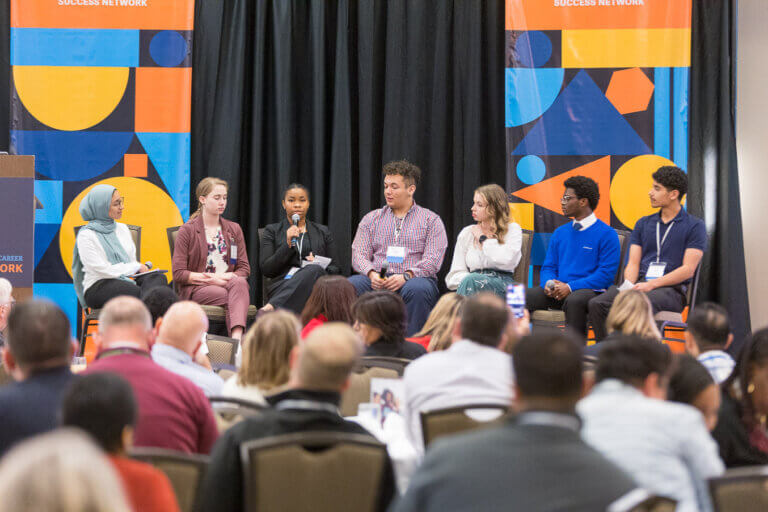At EdSystems, our commitment to leveraging data as a beacon in education remains unwavering. The unveiling of the Illinois State Board of Education’s latest Illinois Report Card for the 2022–23 school year provides a rich tapestry of insights into K–12 public schools across the state. As we delve into the nuances of college and career readiness, this comprehensive set of metrics allows us to celebrate notable strides and critically examine areas requiring heightened attention.
9th Grade on Track: A Resilient Climb
In 2023, the statewide 9th grade on track measure was 87.4%, an increase from the 2022 rate of 86.6% and a continued surge from the 2021 rate of 82.2%. This positive momentum is bringing Illinois freshmen close to the pre-pandemic rate of 88.8% in 2019-20. Significantly, this positive trajectory extends widespread across demographics, showcasing a remarkable recovery for Black and Latinx students, both with an increase of 7 percentage points from 2021 to 2023. This resilient climb is also observed among various groups, such as low-income students (8 percentage points), English Learners (7 percentage points), and students with IEPs (7.5 percentage points). Amazingly, not only have Black students and students with IEPs rebounded, but they’ve surpassed their pre-COVID rates—a triumph indeed!
A Holistic Perspective of CTE Outcomes
Intriguing shifts mark the landscape of Career and Technical Education (CTE). While the percentage of CTE concentrators graduating high school has dipped slightly to 95.8% in 2023 (from 97.1% in 2022), a more nuanced story unfolds when we explore further. Encouragingly, there was an uptick in the percentage of CTE concentrators attaining postsecondary credits in relevant CTE programs post-graduation, rising from 31.6% in 2022 to 38% in 2023. Equally noteworthy is the doubling of CTE concentrators engaged in work-based learning experiences, from 5% in 2022 to 10.3% in 2023. These developments underscore the evolving nature of CTE, offering students both academic and real-world preparation.
A Wave of Opportunity in Dual Credit Enrollment
The momentum toward early college enrollment in Illinois continues to build. For the 2022–23 school year, an impressive 85,182 high school students across grades 9 to 12 engaged in dual credit coursework. The data mark a substantial increase, with more than 4,000 additional students than the preceding year and a remarkable surge of more than 28,000 students compared to five years ago (the 2017–18 school year). Acknowledging the impact of the state’s Model Partnership Agreement for dual credit, pioneered by EdSystems, this surge in dual credit participation and broader exposure to early college coursework positions more students for success in postsecondary endeavors.
Charting Progress in Graduation and Postsecondary Pathways
While overall four-year graduation rates have experienced a marginal uptick from 87.3% for the Class of 2022 to 87.6% for the Class of 2023, the narrative extends beyond percentages. Interventions such as Jobs for America’s Graduates (JAG) showcase a commitment to improving graduation rates for at-risk students. We’re seeing some of the highest increases in four-year graduation rates amongst low-income students and English Learner students, with increases of 1 percentage point and 0.5 percentage points, respectively. Postsecondary enrollment rates are also beginning to rebound, with approximately 65% of the Class of 2021 enrolling in a two- or four-year college within 12 months of graduation. By comparison, approximately 64% of the Class of 2020 enrolled within 12 months, halting a three-year decline in postsecondary enrollment since 2019. This rebound is driven by an increase in four-year college enrollment, with 40% of the Class of 2021 enrolling in four-year public universities, compared to 38% of the Class of 2020.
Unveiling Complexities in Postsecondary Remediation
In previous years we’ve seen a steady decline in the percentage of students taking remedial coursework at an Illinois community college in any area and by subject. The 2023 Report Card data for the Class of 2021 tells a slightly more complex story. The Class of 2021 had approximately 28% (n = 9704) of the 33,695 graduates enrolling in remedial coursework. Comparatively, approximately 27% (n = 9969) of 36,517 students enrolled in remedial coursework from the Class of 2020. What we see here is that overall there are 265 fewer students from the Class of 2021 enrolling in remedial coursework compared to the Class of 2020. However, this is paired with roughly 3,000 fewer graduates from 2021 enrolling in Illinois community colleges. Looking back, there’s actually a steady decline in community college enrollment statewide, with 32% of the Class of 2017 enrolling to now just 25% of the Class of 2021 enrolling in community college. It remains to be seen if a continued effort to invest in increased FAFSA completion, increased dual credit attainment, and more students attaining College and Career Pathway Endorsements will increase postsecondary enrollment in community colleges statewide.
We’re seeing similar trends in remedial math, with a higher percentage of 19.6% (n = 6604) from the Class of 2021 compared to 18.4% (n = 6719) from the Class of 2020, but overall a lower number of students taking remedial coursework in math. The same story holds true for students taking remedial coursework in communications, but remedial reading tells a more positive story. Approximately 3.3% (n = 1112) of students from the Class of 2021 enrolled in remedial reading coursework, compared to 3.5% (n = 1278) of students from the Class of 2020, both a decrease in percentage and number of students. The impact of transitional math under ISBE’s and ICCB’s implementation plan should contribute to continued declines in math remediation rates and number of students, with increasing numbers of students enrolling in credit-bearing college math courses. As EdSystems continues working with the state agencies to increase statewide implementation of transitional English in ways that parallel the statewide system for transitional math, the number of students in remedial communications should continue to decline.
In conclusion, the nuanced data and statistics presented in the 2022–23 Illinois Report Card illuminate the dynamic journey of educational progress. As we applaud achievements, we remain steadfast in our commitment to addressing the evolving needs of our students, fostering an environment that not only celebrates success but also actively prepares them for the complexities of higher education and their chosen careers.


